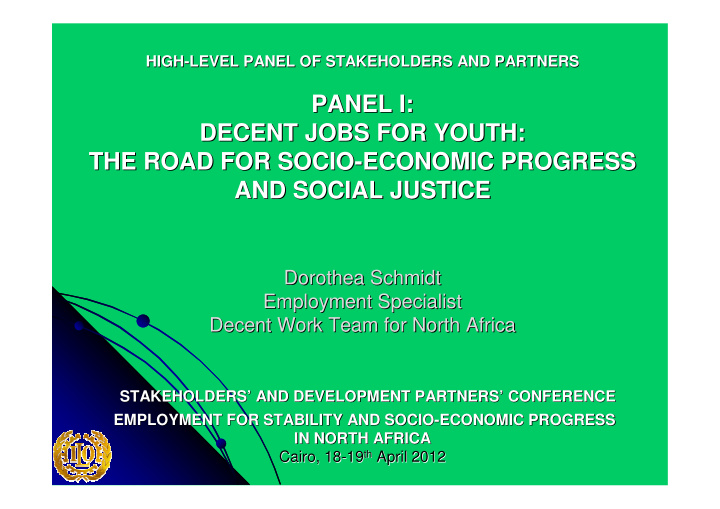



HIGH- HIGH -LEVEL PANEL OF STAKEHOLDERS AND PARTNERS LEVEL PANEL OF STAKEHOLDERS AND PARTNERS PANEL I: PANEL I: DECENT JOBS FOR YOUTH: DECENT JOBS FOR YOUTH: THE ROAD FOR SOCIO- -ECONOMIC PROGRESS ECONOMIC PROGRESS THE ROAD FOR SOCIO AND SOCIAL JUSTICE AND SOCIAL JUSTICE Dorothea Schmidt Dorothea Schmidt Employment Specialist Employment Specialist Decent Work Team for North Africa Decent Work Team for North Africa STAKEHOLDERS’ ’ AND DEVELOPMENT PARTNERS AND DEVELOPMENT PARTNERS’ ’ CONFERENCE CONFERENCE STAKEHOLDERS EMPLOYMENT FOR STABILITY AND SOCIO- EMPLOYMENT FOR STABILITY AND SOCIO -ECONOMIC PROGRESS ECONOMIC PROGRESS IN NORTH AFRICA IN NORTH AFRICA th April 2012 Cairo, 18 18- -19 19 th April 2012 Cairo,
Message 1: GDP growth was considerable Message 1: GDP growth was considerable and did not lag behind Asian tigers and did not lag behind Asian tigers Source: IMF, October 2011 Source: IMF, October 2011
Message 2: Message 2: Job creation did take place, the employment Job creation did take place, the employment response to output growth in the Arab countries response to output growth in the Arab countries was almost double that in the Asian economies was almost double that in the Asian economies (respectively 55% compared to 30%) (respectively 55% compared to 30%) Source: ILO, Global Employment Trends Model, October 2011 Source: ILO, Global Employment Trends Model, October 2011
Message 3: Message 3: Education has improved in terms of numbers, Education has improved in terms of numbers, especially for women; in terms of quality the especially for women; in terms of quality the progress has been less obvious. progress has been less obvious.
Message 4: Demographic trends are (still) positive Message 4: Demographic trends are (still) positive Source: ILO, Global Employment Trends Model, October 2011 Source: ILO, Global Employment Trends Model, October 2011
Message 5: Labour market Message 5: Labour market outcomes remain challenging outcomes remain challenging Challenge 1: High unemployment rates, especially for young people and women Source: ILO, Global Employment Trends Model, October 2011 Source: ILO, Global Employment Trends Model, October 2011
Youth unemployment (15- -24 years) rates 24 years) rates Youth unemployment (15 by world regions by world regions Source: ILO, Global Employment Trends Model, October 2011 Source: ILO, Global Employment Trends Model, October 2011
Challenge 2: High unemployment rates across all income and education levels Source: World Bank, 2009
Challenge 3: Low labour force participation rates Source: ILO, Global Employment Trends Model, October 2011 Source: ILO, Global Employment Trends Model, October 2011
Challenge 4: High employment dependency ratio Source: ILO, Global Employment Trends Model, October 2011 Source: ILO, Global Employment Trends Model, October 2011
Challenge 5: Demand side constraints Table 2: Number of jobs (millions) that would need to be created by 2016 (various scenarios) Remains constant at its 2011 Increases to If the LFP rate level 60% Constant at If unemployment rate 2011 Reduced to 6% Reduced to 6% North Africa 6,3 10,1 27,9 Source: Author Source: Author’ ’s calculations based on ILO, Global Employment Trends Model, Oct s calculations based on ILO, Global Employment Trends Model, October 2011 ober 2011
Challenge 6: Lack of high quality employment Indicator 1: Vulnerable employment Indicator 2: Working poverty at the US$ 2 a day level Source: ILO, Global Employment Trends Model, October 2011 Source: ILO, Global Employment Trends Model, October 2011
Challenge 7: high public employment share (between 10 and 80 per cent) Source: ILO, 2012 Source: ILO, 2012
Challenge 8: Lack of productivity growth Productivity levels and changes measured as output (in total US$) per person employed, world regions 1991 to 2011 Source: ILO, Global Employment Trends Model, October 2011 Source: ILO, Global Employment Trends Model, October 2011
Challenge 9: Slow structural shifts Manufacturing Services Source: ILO, Global Employment Trends Model, October 2011 Source: ILO, Global Employment Trends Model, October 2011
Challenge 10: Social Protection coverage is very low Percentage of people covered and North Africa Source: ILO, 2012 Source: ILO, 2012
Challenge 11: Lack of social dialogue linked to governments (prior to the revolutions) non-representation of youth and women Challenge 12: Non-conducive environment for enterprise creation (especially MSMEs) Challenge 13: Weak employment policies Lack of implementation Challenge 14: Mismanaged migration Brain drain, bad working conditions, discrimination Challenge 15: Lack of solid and transparent labour market information
Conclusions Conclusions � It is not a surprise that these labour market deficiencies added to the frustration of people in the region and continue to be one of the main drivers of protest in all countries � The challenges need to be tackled to ensure social stability and economic progress � It is not about creating any jobs, it is about creating decent jobs � The challenges can only be solved if all partners will be involved
Thanks for your Thanks for your attention attention
Recommend
More recommend